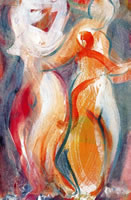Melissa Alley: Colour and Curve by Mary Rose Beaumont, April 2000
“ The purest and most thoughtful minds are those which love colour the most.” John Ruskin “The Stones of Venice”, vol ii, ch.5
Colour, glorious colour is the most striking property of Melissa Alley’s paintings. She starts relatively modestly in the early work with a gentle glissando for brushstrokes; in the most recent work the various strands of symphonic colour rise to a dizzying crescendo. But let it not be thought that is a question of hit or miss. She does not plan her composition in advance, but as soon as the first notes are struck, so to speak, she has her pitch and the painting evolves almost organically under her brush.

Inside Out, 1997, is one of the most exciting of this early group. The figure is there for all to see, exposed to the viewer, but round it and through it lick the elemental flames which both destroy and renew. There is a sense of figure and ground, the ground perhaps a tawny landscape with clumps of green trees over which she has imposed the discipline of a linear figure. Yet there is a sense of something bubbling up inside – a cauldron of human emotions that no lid can keep sealed. The contrasting colours of the spectrum help to achieve an overall harmony – green shading into red, which in turn becomes a glowing orange. She uses the same colours, although in almost exactly the opposite way, to effect a similar harmony in Frisson, 1997,which has a sense of energy and movement pulsating through it. I am reminded with these figures of Rodin, who liked to have dancers wandering through his studio, so that he could catch a quick turn of the body and capture the fleeting moment on paper. Frisson is especially interesting because the artist made the work with her eyes shut, as an intuitive rather than a preconceived composition. In many of the drawings there are two figures, which immediately set up a dialogue, sometimes tense and strained, sometimes warm and affectionate. In this particular case the viewer has to ask him/herself: Are they turning away from each other or have they just been reunited? It should be remarked that Alley’s figures are nearly all women, perhaps because to be true to herself she can only be sure of female emotions and behaviour.

A solemn ritual is being enacted in Entities in Procession, 1998-00. The archetypal figures move slowly across the picture plane. It might be seen as part of a great Last Judgement, with the figures descending into limbo or, in a more pagan light, as a group processing towards an unseen sacrificial altar. The central figure is the focal point of the group, slightly set apart from the others, perhaps an act of worship. Certainly she may be connected with Gaea, Mother Earth, literally the most solid of the figures apart from the armless, headless statue to her right reminiscent of the Venus de Milo. The other figures are mysteriously transparent and the landscape may be seen through and beyond them, offering an interplay between positive and negative space.
Alley describes her work as being “on the cusp between abstraction and figuration”, and nowhere is this truer than in the most recent paintings in mixed media on wood which possess, in common with early pioneering Kandinsky, the quality of metamorphosis from figuration into abstraction and back again. If there is a metaphor to be discovered in this paeon of praise to colour it is that the death of painting is greatly exaggerated.
Colour and Curve1986-1998